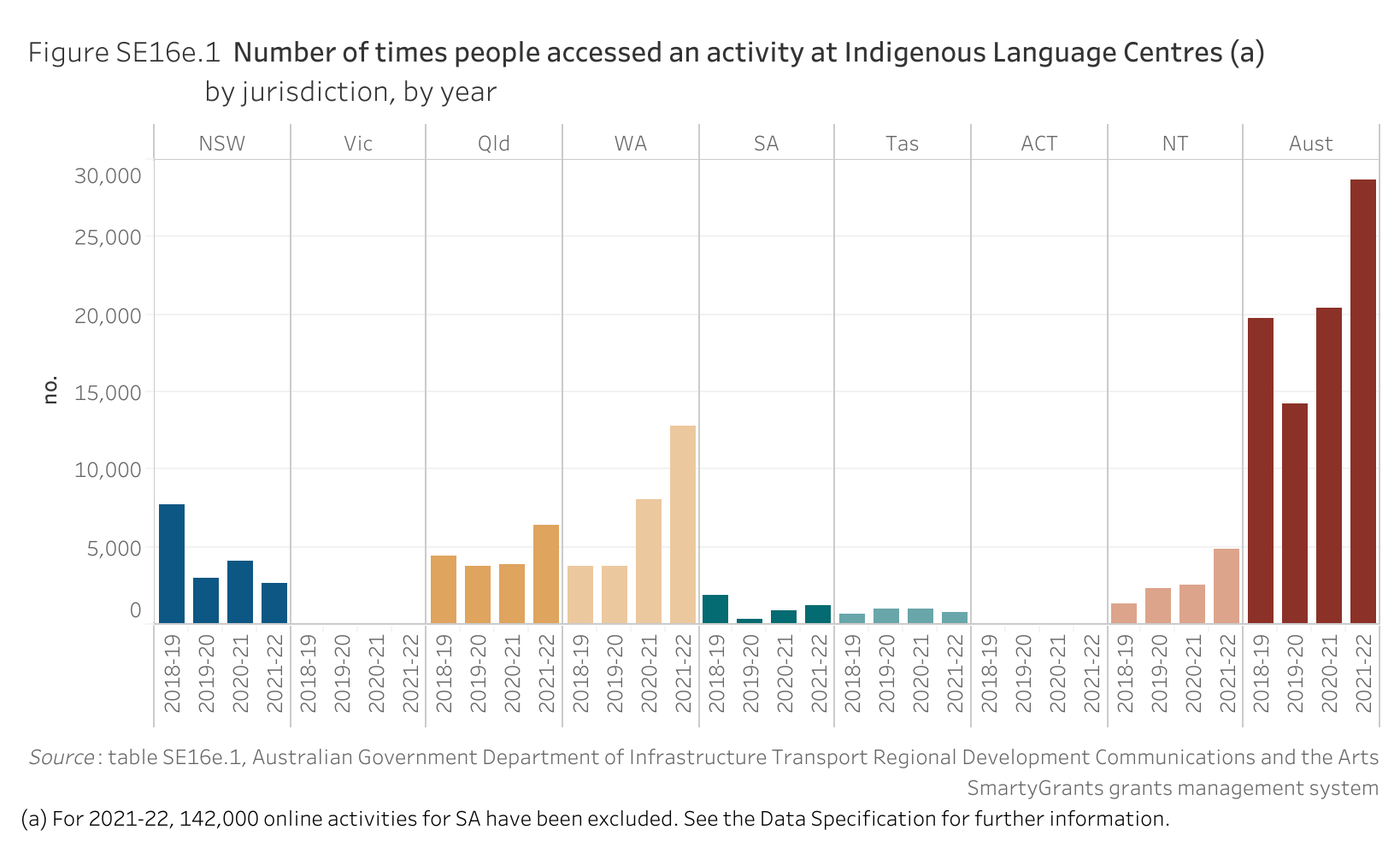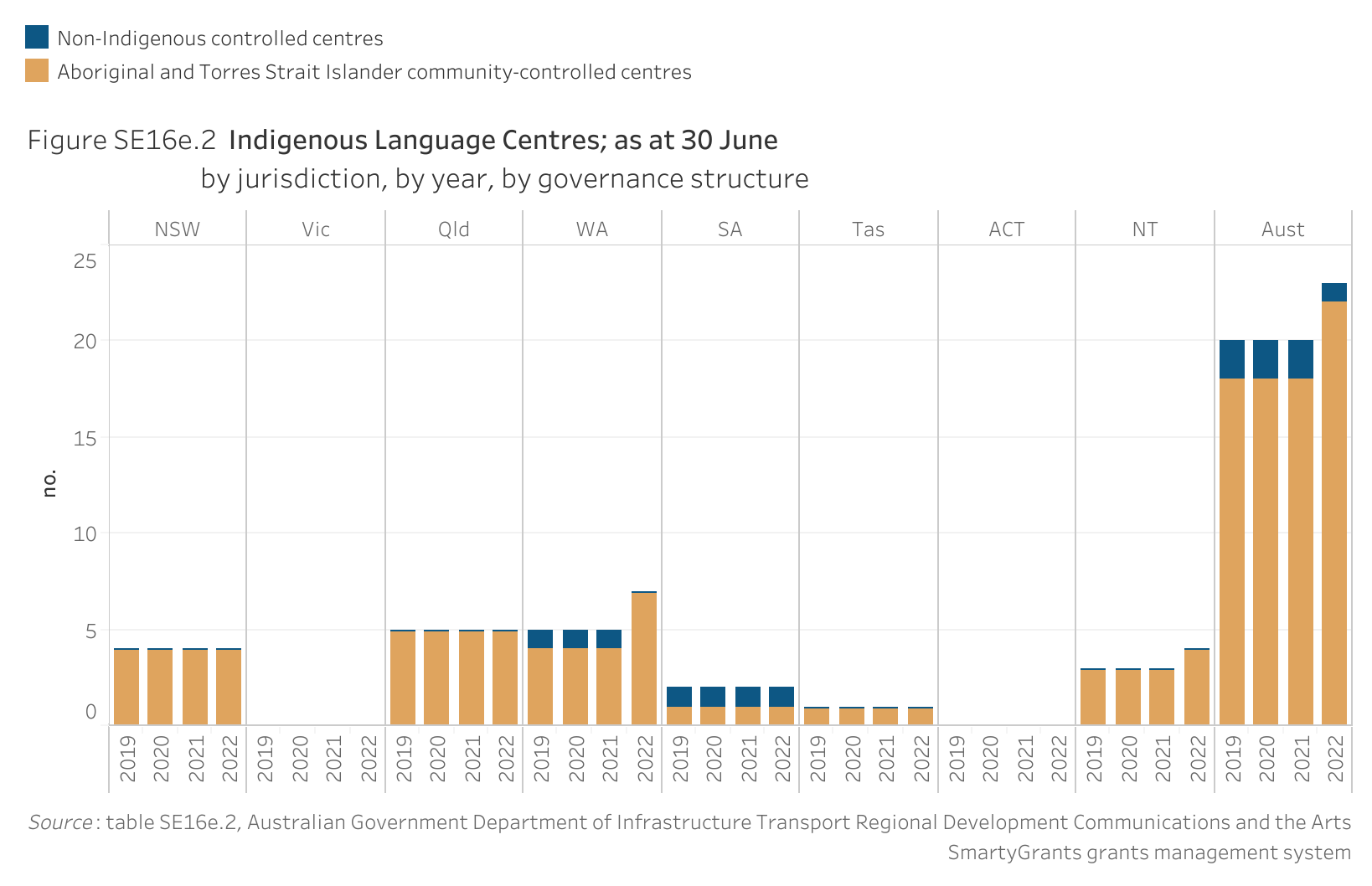Contextual information
Number of Aboriginal and Torres Strait Islander people accessing Commonwealth funded language centres to maintain and preserve languages
Dashboard snapshot: The data below are the most recent at the time of preparing the July 2023 report. Please go to the dashboard to access the current data.
Measure 1
Number of times people accessed an activity at Commonwealth funded Indigenous Language Centres
Nationally in 2021-22, 28 663 activities were accessed at Commonwealth funded Indigenous Language Centres (figure SE16e.1).

| Year | NSW | Vic | Qld | WA | SA | Tas | ACT | NT | Aust |
|---|---|---|---|---|---|---|---|---|---|
| 2018-19 | 7,689 | – | 4,417 | 3,742 | 1,880 | 650 | – | 1,345 | 19,723 |
| 2019-20 | 3,030 | – | 3,774 | 3,774 | 348 | 1,020 | – | 2,277 | 14,223 |
| 2020-21 | 4,032 | – | 3,910 | 8,085 | 886 | 1,020 | – | 2,510 | 20,443 |
| 2021-22 | 2,600 | – | 6,406 | 12,821 | 1,236 | 768 | – | 4,832 | 28,663 |
– Nil or rounded to zero.
Measure 2
Number of Commonwealth funded Indigenous Language Centres by governance structure
Nationally, as at 30 June 2022, there were 23 Commonwealth funded Indigenous Language Centres across Australia, of which 22 were Aboriginal and Torres Strait Islander community-controlled and one was non-Indigenous controlled (figure SE16e.2). This is the first increase in the number of Commonwealth funded Indigenous Language Centres since the 2019 baseline year, with an increase of 3 overall in the 12 months to 30 June 2022 (a combination of an increase of 4 Aboriginal and Torres Strait Islander community-controlled centres and a decrease of 1 non-Indigenous controlled centre).

| Year | Description3 | NSW | Vic | Qld | WA | SA | Tas | ACT | NT | Aust |
|---|---|---|---|---|---|---|---|---|---|---|
| 2019 | Non-Indigenous controlled centres | – | – | – | 1 | 1 | – | – | – | 2 |
| Aboriginal and Torres Strait Islander community-controlled centres | 4 | – | 5 | 4 | 1 | 1 | – | 3 | 18 | |
| 2020 | Non-Indigenous controlled centres | – | – | – | 1 | 1 | – | – | – | 2 |
| Aboriginal and Torres Strait Islander community-controlled centres | 4 | – | 5 | 4 | 1 | 1 | – | 3 | 18 | |
| 2021 | Non-Indigenous controlled centres | – | – | – | 1 | 1 | – | – | – | 2 |
| Aboriginal and Torres Strait Islander community-controlled centres | 4 | – | 5 | 4 | 1 | 1 | – | 3 | 18 | |
| 2022 | Non-Indigenous controlled centres | – | – | – | – | 1 | – | – | – | 1 |
| Aboriginal and Torres Strait Islander community-controlled centres | 4 | – | 5 | 7 | 1 | 1 | – | 4 | 22 |
– Nil or rounded to zero.
Indicator data specifications
Related outcome: | Aboriginal and Torres Strait Islander cultures and languages are strong, supported and flourishing. |
|---|---|
Related target: | By 2031, there is a sustained increase in number and strength of Aboriginal and Torres Strait Islander languages being spoken. |
Indicator: | Number of Aboriginal and Torres Strait Islander people accessing Commonwealth funded language centres to maintain and preserve languages. |
Measure: | Measure 1 This measure is defined as: Numerator — the number of times people accessed an activity at Commonwealth funded Indigenous Language Centres and is presented as a number. Measure 2 This measure is defined as: Numerator — the number of Commonwealth funded Indigenous Language Centres, that are:
and is presented as a number. |
Indicator established: | National Agreement on Closing the Gap July 2020 |
Latest dashboard update for the indicator: | 8 March 2023 |
Indicator type: | Contextual information |
Interpretation of change: | For both measures, an increasing number (and particularly for Aboriginal and Torres Strait Islander community-controlled centres) is generally desirable as this indicates greater access to these services, but access to services should be considered in the context of population need. |
Data source(s): | Name: SmartyGrants grants management system Frequency: Annual Documentation (links): https://www.arts.gov.au/funding-and-support/indigenous-languages-and-arts-program |
Data provider: | Provider name: Department of Infrastructure, Transport, Regional Development, Communications and the Arts Provider area: Indigenous Languages and Arts Program |
Baseline year: | 2018-19 |
Latest reporting period: | 2021-22 |
Disaggregations: | Measure 1: State and territory and Australia Measure 2: State and territory and Australia, by governance structure |
Computation: | Counting rules Measure 1 The number of times people accessed activities delivered by Commonwealth funded Indigenous Language Centres (ILC), over a financial year. Activities include participation in centre-based Indigenous language activities, (such as Indigenous language teaching and learning programs) delivered face to face or online. A person accessing an ILC activity is recorded each time they participate (each time they attend an ILC and each time they log on online); hence a person can be counted more than once over a 12-month period. Online access is counted according to the location of the ILC, not the location of the person accessing the ILC. The majority of activity recorded is face-to-face for all jurisdictions except SA. In SA there was a significant increase in activity in 2021-22 with 142 000 counts of online access. The online access counts have been removed from SA for 2021-22 with work underway to enable disaggregation of future reporting for this measure by method of access (face-to-face and online). Therefore, data for SA for 2021-22 includes face-to-face counts only. Measure 2 The number of Commonwealth funded ILCs nationally. This includes ILCs that receive annual operational funding under the Indigenous Languages and Arts program to work on identifying, preserving, and revitalising Aboriginal and Torres Strait Islander languages. ILCs are counted separately for each location in which they operate. State and territory is based on the location of the ILC. Services are counted as at 30 June, annually. An ‘Aboriginal and/or Torres Strait Islander Community-Controlled Organisation’ is classified under the following Tiers:
‘Non-Indigenous controlled’ centres include not-for-profit community-based organisations and may operate through a range of governance structures controlled by non-Indigenous organisations, with various Aboriginal and Torres Strait Islander community advisory and input arrangements. |
Data quality considerations: | Measures 1 and 2 Data collection within ILCs may vary across locations. Measure 1 only The Indigenous status of people engaging in activities is not currently collected and therefore data will include any person engaging in an activity in a Commonwealth Funded ILC. A disaggregation by Indigenous status will enable reporting for Aboriginal and Torres Strait Islander people in line with the wording of the indicator in the National Agreement. Some ILCs were not able to provide data on the number of people accessing activities. Therefore, there may be an undercount of people for this measure. |
Future reporting: | Additional disaggregations required for future reporting:
|
